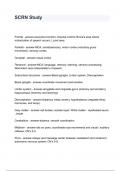SCRN Study
Frontal - answer-executive function, impulse control; Broca's area where
motorization of speech occurs; L post area.
Parietal - answer-MCA; somatosensory; motor cortex (voluntary gross
movement), sensory cortex.
Occipital - answer-visual cortex
Temporal - answer-MCA; language, memory, learning, sensory processing;
Wernicke's area interpretation of speech.
Subcortical structures - answer-Basal ganglia, Limbic system, Diencephalon
Basal ganglia - answer-coordinate movement and emotion
Limbic system - answer-amygdala and cingulate gyrus (memory and emotion),
hippocampus (memory and learning).
Diencephalon - answer-thalamus (relay center), hypothalamus (regulate thirst,
hormones, and temp).
Grey matter - answer-cell bodies; outside layer; White matter - myelinated axons
, inside
Cerebellum - answer-balance, smooth coordination
Midbrain - answer-sits on pons; coordinates eye movements and visual / auditory
reflexes; CN's 2-4.
Pons - answer-relayer and message center between cerebellum and cerebrum,
autonomic nervous system; CN's 5-8.
,Medulla oblongata - answer-relay center, CN's 9-12
CN 1 - answer-Olfactory
CN 2 - answer-Optic
CN 3 - answer-Oculomotor - looking up.
CN 4 - answer-Trochlear - looking down and in.
CN 5 - answer-Trigeminal - face senses, chewing.
CN 6 - answer-Abducens - looking down and out.
CN 7 - answer-Facial - raise eyebrows, smile, puff cheeks.
CN 8 - answer-Acoustic
CN 9 - answer-Glossopharyngeal - oral sensation, taste.
CN 10 - answer-Vagus - parasympathetic innervation.
CN 11 - answer-Spinal accessory - shoulders up and down, turning head.
CN 12 - answer-Hypoglossal - tongue side to side.
Large vessel - answer-Carotid, vertebral, ACA, MCA, PCA; Caused by thrombus
or embolus typically; ICH at junctions or vessel turns; SAH aneurysms often at
vessel bifurcations
Carotid stroke - answer-Significant stroke, large territory; Contralateral motor and
sensory loss, homonymous hemianopsia; Aphasia if dominant side, contralateral
neglect if non-dominant side.Ipsilateral gaze preference, Amaurosis fugax,
Horner's Syndrome
Amaurosis fugax - answer-transient monocular blindness.
, Horner's Syndrome - answer-due to carotid dissection; Ptosis (drooping eyelid),
Miosis (pupillary constriction), anhidrosis (decrease facial sweating).
Ant. Cerebral Art (ACA) - answer-ant circulation. Frontal lob, ant portion parietal
lobe, olfactory cortex, corpus callosum, leg motor cortex
ACA Stroke - answer-Stroke = Leg weakness > arm weakness, apathy, poor
reasoning and judgement, conjugate eye deviation, abulia (lack of expression,
and talking). Contralateral motor / sensory
Middle Cerebral Art (MCA) - answer-ant. Circulation. Surface of cerebral cortex,
portion of frontal; parietal, and temporal lobe. Basal ganglia, internal capsule
MCA Stroke - answer-aphasia if L hemi, neglect if R hemi; ipsilateral forced eye
deviation, contralateral homonymous hemianopsia and motor / sensory loss,
arms weaker than legs
Post. Cerebral Art (PCA) - answer-occipital lobe, deeper post. Brain structures.
Basilar artery, posterior cerebral artery (PCA), superior cerebellar artery (SCA),
anterior inferior cerebellar artery (AICA), and posterior inferior cerebellar artery
(PICA).
PCA Stroke - answer-less common; contralateral loss of pain and temp
sensation, visual field loss
Weber's Syndrome - answer-Midbrain stroke; ipsilateral gaze weakness,
contralateral weakness of UE and LE.
Perinauds Syndrome - answer-dorsal midbrain syndrome; vertical gaze palsy,
pupils mid-dilated with light dissociation, convergence-retraction nystagmus
PICA Stroke - answer-possible Horner's Syndrome; Wallenberg Syndrome;
ipsilateral limb ataxia, contralateral pain and temp. sensation; Vertigo, nausea,
hiccups




